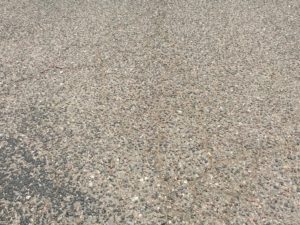What is Raveling?
17 May, 17 /
Asphalt Repairs, Raveling

Have you ever walked through a parking lot and noticed loose rocks and debris? If so, the asphalt may have been raveling right under your feet! Raveling is known as the deterioration of pavement by the loss of asphalt and rocks. This is evident by the rocks and sand on the pavement surface and in gutters. Over a period of time, the thickness of the pavement begins to dwindle away, until the entire pavement has eroded completely.
What are the main causes of raveling?
- Dust Coating: The aggregate particles can cause a layer of dust to form on top of the pavement, which the asphalt binder then bonds with instead of the aggregate.
- Aggregate Segregation: Pavement is layered with aggregate, which is made up of different sized rocks that are crushed and screened. The aggregate provides a packing structure, and when spaced adequately, it also provides necessary air voids. The aggregate matrix needs fine particles, and if these are missing, the asphalt binder has only a few contact points to bind the coarse particles that still remain. This process is important to the overall stability of the pavement, and without it, pitting can occur.
- Inadequate Compaction: If asphalt has not been adequately compacted during construction, it won’t sufficiently bond with the asphalt mix. High density is needed to create this cohesion, and asphalt can ravel without it. Asphalt that isn’t properly compacted can perform poorly and experience rutting, ultimately lowering its longevity and durability.
- Traffic Dislodging: In high-traffic areas, repair for raveling is par for the course, as the pavement endures a large amount of wear and tear on a day-to-day basis.
Severity of Raveling
The damage caused by raveling in your pavement depends on its severity level. The level can help you gauge what sort of repair to expect and how well your current pavement will most likely hold up in its current state.
- Low—The pavement is only a little rough and looks slightly aged.
- Medium—The surface of the pavement somewhat rough and pitted. There is some fine aggregate missing from the pavement’s surface.
- High—The surface is very rough and has deep pits. Fine aggregate isn’t visible on the surface of the pavement, and the pitting is about one half the size of the coarse aggregate in depth.
Repair for raveled pavement varies depending on its severity and root cause. If the raveling is present in only small, localized areas, the construction team will generally remove the raveled pavement and replace it. For large areas of raveling, general asphalt damage is generally the culprit. The damaged pavement is generally removed in this case, and an overlay is applied.
Suspect your pavement is raveling? Call Sunland Asphalt to scope your property and for a free estimate! Sunland Asphalt is the most reliable asphalt maintenance contractor in the southwest and our crew is ready to execute any pavement maintenance solution to meet your schedule and your budget.
Contact Our Experts